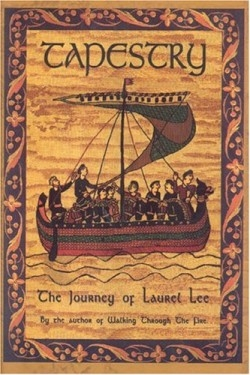Tapestry
The Journal of Laurel Lee
Everyone knows someone like the author—she represents the hippy earth—mother who never outgrew her ideals, the one who managed to retain a childlike innocence through the trials and tribulations of a lifetime. Neither divorce nor cancer nor poverty dampen her spirit or her faith in God, as her new biography demonstrates.
Lee has published before: Walking through the Fire, an adaptation of the diary she kept as she grappled with Hodgkin’s Disease, became a best seller that was distributed in more than fifty countries. She also wrote Signs of Spring, Mourning into Dancing, and Godspeed, winning the Bookseller’s Association award for best nonfiction in 1977. Her husband, Mike Thaler, is a successful children’s book author.
Lee’s past accolades make Tapestry an anticipated work. Although she would never portray herself as a hero, her life is the kind of epic tale that might be conveyed on a rich tapestry. Her youthful naiveté is timeless, her struggle with cancer inspiring. She fulfills her role as mother and wife (“A mother has had to be painted by every generation,” she reminds readers) while establishing a writing career. And she overcomes poverty to gain the financial stability needed to travel around the world.
She subtly weaves threads of her Christian faith into her tale, not because she’s trying to convert her audience, but simply because her faith is often what sustains her. When she finds out, for example, that an examination indicates Stage III Hodgkin’s Disease, Lee explains, “My agony actually turns into joy, which is beyond understanding. And joy is one with peace. I am in a very high place, and I want to look around. For a very brief time, I am on top of the embroidery instead of on the bottom side where the knots are and the threads cross. It is a perfect work.”
Lee spins unusual metaphors like this into her narrative, helping the reader share in her feelings and experiences. After her first divorce, she cares for her three children alone. “Nights became the longest train ride. Mary Elisabeth always throws her bottle out of the crib. She cries like the lonely whistle as it crosses the 2:00 a.m. of Kansas. Everything is dark and flat.” When her second husband invites his daughters to come live with them, she explains: “I said the noble words, ‘I’ll do my best,’ but my phrase was a corset, and I could feel the flesh squeezed and bulging around my declaration.”
Life is full of quiet moments that are occasionally interrupted by momentous changes. Appropriately, Lee’s narrative slows to a crawl at times. However, her creative language carries the reader through, and in the end, Tapestry is more like a friendship than a book.
Reviewed by
Jennifer Hoffman
Disclosure: This article is not an endorsement, but a review. The publisher of this book provided free copies of the book to have their book reviewed by a professional reviewer. No fee was paid by the publisher for this review. Foreword Reviews only recommends books that we love. Foreword Magazine, Inc. is disclosing this in accordance with the Federal Trade Commission’s 16 CFR, Part 255.

